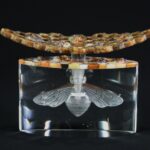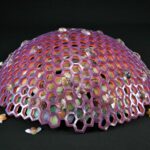My works can be roughly grouped into three categories: mosaic works, insect motifs, and vessels as thick as eggshell-thin.
While traveling, I saw a mosaic in the ruins of a Roman building. The colors of it had faded away in the dry and dusty air, but when a worker splashed water on it, the colors regained their original beauty, which struck my eyes and remained in my memory vividly and permanently. I also saw the stone-paved streets and squares, long and wide, which consisted of an endless continuation of stones as small as only four inches long. I was fascinated by these stones which, like mosaic pieces, seemed to embrace a mystical power of becoming immense architectural structure when put side-by-side with the human hand.
I have been fascinated by insects since I was a child, because of their appearance, color, and the mystery of life that lives in the nature around me.
When I visited the Kitazawa Museum of Art, which is known for its 19th century glass collection, I saw my first time, Art nouveau glass pieces, pieces as thick as eggshells. I was particularly impressed by the very thin ware and tried to recreate this techniques, which was successful and allowed me to manage this technique.
私の作品は、モザイクを駆使したもの、昆虫をモチーフとしたもの、卵の殻ほどの厚さの胎と、大まかに分けることができます。
古代ローマ遺跡の発掘現場で、土ぼこりに乾いた床のモザイクが発掘人の撒いたバケツ一杯の水によって、一瞬当時の鮮やかさを取り戻した時の刺激的な印象や、モザイクにも似て、たかが10㎝ほどの石が一個ずつならべられて、ついには広く長くつながる道や広場になる積み重ねの力に感動したことに起因します。
昆虫は、子供のころから今に至るまで、その姿、色など身近な自然の中に息づく生命の営み、神秘に魅せられことによります。
北澤美術館で初めてアールヌーボー期のガラスを目にし、中でも非常にデリケートな卵の殻ほどの厚さの作品に魅了され、その製法の再現に挑み、成し遂げ、技法を操れることからこの技法による作品を制作しています。








